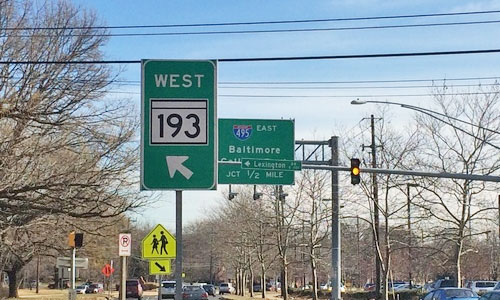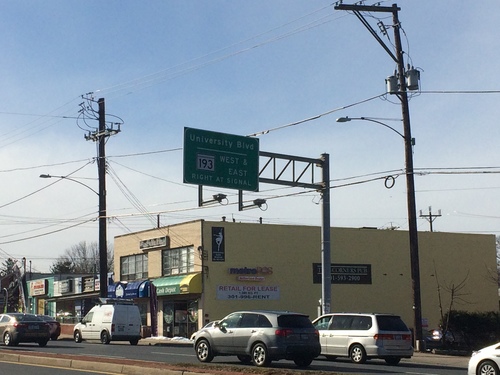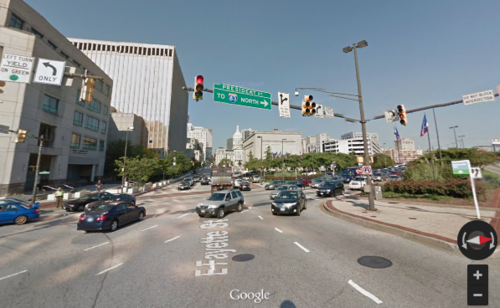Freeway-style signs send drivers the wrong message
Signs above intersections can help drivers find their way. But large, freeway-style signs encourage drivers to think of neighborhood roads like stretches of highway rather than looking for pedestrians and local businesses. They also mar historic streetscapes.

A sign over the westbound lanes of University Boulevard in the heart of Four Corners’ commercial district. All photos by the author.
Silver Spring’s Four Corners area provides an example. When the Maryland State Highway Administration widened the intersection to help with traffic flow in the mid-90s, it added new turn lanes on both Colesville Road and University Boulevard so that drivers turning wouldn’t block those continuing straight. Adding more lanes was also supposed to make getting to the Beltway easier.
Unfortunately, these signs make Four Corners look more like a truck stop on a rural interstate than the unique and historic community that it actually is. Four Corners doesn’t need these signs, and actually, they’re harmful to our community. Here are a few reasons why:
1. They diminish pedestrian safety
The intersection’s design combines with the interstate-style signs to send a message to drivers that they are on a high-speed expressway. Drivers will be less inclined to look out for people walking or biking as they would on a slower speed street through a commercial district.
People driving off the Beltway and traveling through Four Corners see the same types of signs (and lane widths) as they did on the highway they just left. Though they should slow down and watch for people on foot and bikes, they’re cued to drive fast; unsurprisingly, they often drive through the intersection at 50 or 55 miles per hour.
Four Corners is home to both dozens of local businesses that a lot of people walk to and one of the largest high schools in Maryland, and pedestrian safety there should be a top priority.

Signs denoting the crosswalks are dwarfed by signs that look like they belong on the Beltway, not on a community street with pedestrians, schools, and businesses.
2. They distract from local businesses
Nearly all of Four Corners’ community shops sit on its main streets, University Boulevard and Colesville Road. When people speed down the road, they’re less likely to see local businesses. It’s pretty hard to take in your surroundings if you’re driving 50 miles per hour or more down a road that feels more like an interstate than a commercial street.
Thankfully, Four Corners’ local businesses thrive on support from nearby residents, so they aren’t losing out too much. But that just brings us back to the problem I wrote mentioned first: Four Corners’ poor road design and the visual cues that indicate it’s an area only for cars make for an unpleasant walk, which deters foot traffic.
3. They’re far bigger than they need to be
These signs could easily be made smaller and replaced with ones that are more community sensitive in terms of scale. Instead of being placed on large freestanding gantries, the signs could be installed on existing traffic signal poles, like this one in Balitmore.
Of course, we don’t need to get rid of signs altogether. But we can definitely replace them with ones that aren’t so big.
Four Corners isn’t the only place where this is an issue. Residents around New York Avenue in DC have asked to get rid of such signs. Removing signs like these would take an important step toward making roads feel more human in scale and make an area look and feel like the vibrant, diverse community that it actually is.


